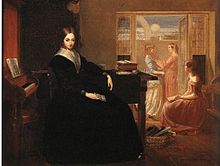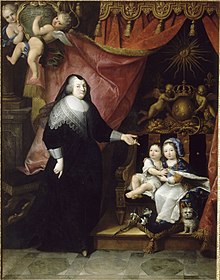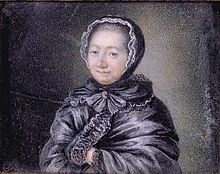Governess
![]()
This article is about the profession. For other meanings The governess (disambiguation).
Governess (from Latin gubernare, meaning to direct, guide) is an outdated term for a home teacher or governess. The term is rarely used nowadays and has acquired a negative connotation. "Governess-like" is used, for example, to refer to a strict style of dress that does not necessarily look advantageous. In a modified sense, it is still used today in the hotel industry: In Switzerland, the housekeeper who guides the chambermaids in their work is called a floor governess.
Originally, it was families of the high nobility who entrusted the upbringing of young children or older daughters to a governess or court mistress. In Great Britain, from the second half of the 18th century, it also became customary in middle-class circles to employ a governess. In Germany and France, on the other hand, the employment of a governess remained limited mainly to families of the upper bourgeoisie and the nobility.
For women of the educated middle class, the work of a governess was one of the few opportunities to pursue a profession befitting one's status for over two centuries. It was taken up almost exclusively by women who, at a certain point in their biography, had no father, husband or brother to support them and who therefore had to or wanted to provide for themselves. In Britain around the middle of the 19th century, so many women were forced to earn their living in this way that they were referred to as "governesses' misery". This was understood to mean material hardship, the damage to self-esteem caused by the low esteem in which this profession was held, disregard for their individual needs, and the struggle to find a profession befitting their status in a labour market that offered women only very limited opportunities compared to men. The governess occupies a correspondingly wide space in English literature of the period. Novels such as Jane Eyre by Charlotte Brontë and Agnes Grey by her sister Anne Brontë have shaped the image of the governess to this day. In other European countries, other social conditions and an earlier schooling of girls' education meant that the profession of governess did not develop into a comparatively strong symbol of specifically female disadvantage.
For a long time, at least in Great Britain, the exercise of the role of governess was not preceded by any pedagogical training. Only the descent from a "good" family justified the right to exercise it. In Germany, on the other hand, the first female teacher training colleges were established as early as the beginning of the 19th century. With increasing speed, further training colleges for female teachers were established, whose graduates often worked temporarily in private homes. They were increasingly called governesses and home teachers. The governess, who for a long time embodied the working woman in a qualified profession par excellence, therefore also stands for the advance of women into a qualified field of gainful employment, when the bourgeois vision of gender relations assigned women only the role of wife, housewife and mother.
Examples of women who worked temporarily as governesses include the writers Anne and Charlotte Brontë, the women's rights activist Mary Wollstonecraft, the later Nobel Peace Prize winner Bertha von Suttner, the Nobel Prize winner in chemistry and physics Marie Curie, the salonnière Henriette Herz, the German women's rights activists Minna Cauer, Helene Lange, Auguste Schmidt, Franziska Tiburtius, Clara Zetkin and the zoologist Katharina Heinroth.

Richard Redgrave, 1844: The Governess
Court origin
The title governess was originally used analogously to the term court master. Court masters were persons who were in charge of the royal household and the service around the monarch. A governess or court mistress originally managed income of princely children, hired servants and teaching staff for them, and occasionally gave them lessons herself. In Germany, where courtly life had become more lavish since the 17th century, following the example of Versailles, and where prince, princess and princely children each had their own households, it was usually members of the local nobility who held such posts. They were usually recruited from the group of noble women living at or close to the court, whose manners and character were well known.
The social status of such a governess - unlike what would later be the case in bourgeois households - was clear; the task was usually associated with considerable prestige. Governesses received fees, gifts, and usually pensions. Close ties often developed between governess and pupil. Examples of this are Elisabeth Charlotte of the Palatinate and her court mistress Anna Katharina von Uffeln, Maria Anna Christiana of Bavaria and her governess Magdalena Maria Countess Portia, Frederick the Great and Marthe de Roucoulle, Wilhelmine of Prussia and Sophie von Danckelmann, Luise of Mecklenburg-Strelitz and Salomé von Gélieu, and the later British Queen Victoria and Baroness Louise Lehzen. Antonie Forster, Georg Forster's sister, remained in close contact with her former pupils, the daughters of the Dukes of Courland, and was a guest of Wilhelmine von Sagan for months in her old age. Elisa von Ahlefeldt, in one of her first acts after taking over her father's inheritance, paid her governess Marianne Philipi the pension that her father Friedrich von Ahlefeldt-Laurvigen had promised her former governess for life but had not paid for 21 years.
A few governesses achieved great influence. The best known is probably Françoise d'Aubigné, Marquise de Maintenon, who became governess to the children of Madame de Montespan and Louis XIV in 1669 and got on better and better with their father over the years. In 1684, a year after the death of the French queen, Louis XIV entered into a secret marriage with the Marquise de Maintenon. In 1686, she founded a boarding school for penniless aristocratic daughters in Saint-Cyr, which existed until 1793 and where she herself spent her twilight years.

Louis XIV with his brother Philippe and the governess Madame Lansac
Pedagogical justification of the governess system
From today's perspective, the pedagogical relationship between governess and pupil is described as "theory-less" for Germany in the 18th and 19th centuries. There were no recognised methods of educating girls in the home, whereas this was very much the case for educating boys in the home. Some pedagogical writings do mention the governess, however. August Friedrich Wilhelm Crome, for example, in his Über die Erziehung durch Hauslehrer (1788), argues that education should only be provided by the tutor. August Hermann Niemeyer, on the other hand, described in 1796 in his Ratgeber für Hofmeister that the governess was responsible for the education of girls, while the tutor was responsible for the education of boys. Both may teach the other's pupils by the hour. If a household employed only one governess, then she took over the education of the boys until they were about eight years old.
François Fénelon and Jeanne-Marie Leprince de Beaumont
The situation was different in France, where criticism of the education of girls in convents and the associated demand that mothers should take care of the education and teaching of their children also gave rise to a theoretical foundation for the education of girls by governesses. In 1687, François Fénelon, in his Traitée de l'éducation des filles (On the Education of Daughters), had called for girls to be educated in the family because, in his view, the mother could better prepare her daughters for their future role as housewife, wife, and mother. If other duties or lack of knowledge prevented her from doing so, she was allowed to be represented and relieved by governesses. In order to prepare her for her future role in the family and society, instruction was to be limited to religion, writing, reading, arithmetic, law, history, Latin and needlework. Only if the girl showed special talent should she also be taught music and drawing. Fénelon's writing was long influential in much of Europe. Among others, it was translated into German by August Hermann Francke in 1698 and adapted to Protestant living conditions. Building on the ideas of Fénelon and John Locke, in 1749 the English writer Sarah Fielding described the home-based individual education of middle-class girls in The Governess; or, Little Female Academy. Instruction was limited to reading, writing, work, and "all proper female instruction." However, Practical Education (1798), written by Maria and Richard Lovell Edgeworth, and the writings of Anna Laetitia Barbauld and Mary Wollstonecraft were also influenced by similar Enlightenment ideas.
Jeanne-Marie Leprince de Beaumont, who temporarily educated the daughter of the politician Carteret in London, first published her Magasin des Enfans (Magazine for Children) in 1757, which was also published in English, German, Russian, Italian, Greek and Spanish shortly afterwards. In addition to fairy tales and stories, it also contained instructional discussions between educator and pupil, the goal of which was "...to form the manners, to take care of the intellect, to excerpt it, to give it a geometric turn, to furnish the exterior." In 1764, Le Magasin des Jeunes Dames (Magazine of Young Ladies) was published, in which the author not only discusses the choice of a husband in instructional conversations with her now adult pupils, but also instructs them on how to choose a governess and how to behave toward her. A governess, in de Beaumont's view, had to have full authority over her pupil, and though she must treat each child differently according to his individuality, she must constantly supervise, mould, and keep him away from evil influences. In her own conduct towards the child she must always have the aims of her education before her eyes.
Madame de Genlis
Of similar importance to de Beaumont's writings are the publications of Stéphanie-Félicité du Crest de Genlis, who entered the service of the Duke and Duchess of Chartres with her husband in 1772. In 1777 she was appointed governess to the ducal couple's twin daughters. Influenced by Jean Jacques Rousseau, de Genlis took over the care of the two girls from infancy and raised them away from the ducal household along with her own daughters. In 1782, she was also given the high office of governor for the sons of the ducal couple. This office was actually reserved for men only, and the appointment, which provoked derisive mocking poems and public protests in France, had to be confirmed by Louis XVI. De Genlis was thus not only responsible for choosing the boys' teachers, but also determined how children were to be educated. She described her ideas about home education in the epistolary novel Adèle and Théodore (1782). She advocated child-centered instruction and called for an education for girls that was geared to the practical, everyday needs of their respective classes. Her method of teaching foreign languages, in which children were to learn a language through everyday interaction, was particularly innovative. Even more than de Beaumont, she emphasized the complete authority of the governess as an educational expert. By contrast, de Genlis rejected the education of girls as "learned women." Jeanne Louise Henriette Campan, who rose from a petty-bourgeois background to become a reader at Versailles and a chambermaid to Queen Marie-Antoinette, and who later ran boarding schools for girls, made even lower demands on the education of girls. She was concerned with the working conditions of governesses because graduates of her school often took up this profession. At the beginning of the 19th century, Campan recommended that governesses should not only be attuned to their pupils, but also to their parents and all other members of the household. She also suggested that they should always be aware of their position as employees, even if they were treated as a member of the family. Thus, she was not to attend social gatherings where the child was not allowed. The focus of education was to be piety, charity, sobriety, cleanliness and order. In arithmetic, on the other hand, the teaching of the simplest skills sufficed. Needlework, playing the piano, and drawing were further focal points of instruction.
During the 19th century, no theoretical or methodological development of governessing occurred. Educated parents and governesses were essentially content with new editions of the Magazine for Children when looking for educational writings.

Madame de Genlis, painted by Adélaïde Labille-Guiard in 1780

Jeanne-Marie Leprince de Beaumont
Questions and Answers
Q: What is a governess?
A: A governess is a female person who works for a family, teaching the children in their home. She is not like a nanny who looks after them all day, dressing them etc. The governess's job is to be their teacher and saw to their discipline and early education.
Q: How common was it for families to have a governess?
A: It was quite common in the families of rich people until around the beginning of the 20th century. In England quite a lot of young children who lived in the country, a long way from good schools, had a governess. Very few children nowadays have one.
Q: What did they teach?
A: Governesses taught basic skills such as Reading, Writing and Arithmetic. They may also have taught other skills such as French, piano playing and drawing or painting. Sometimes other teachers might be hired for specific subjects like music or art lessons.
Q: Was she treated like part of the family?
A: No, she was not treated like a member of the family but also not considered as household worker either so she often felt quite lonely and usually ate her meals alone.
Q: Why would someone become a governess?
A: For girls from middle class backgrounds who were not married it was one of only ways of earning living at that time so many women chose this profession out of necessity rather than choice.
Q: Are there any famous examples in literature or film?
A: Yes, novels by Charlotte Brontë (Jane Eyre) and Anne Brontë (Agnes Grey) feature characters with this role while Maria from The Sound Of Music leaves convent to become von Trapp family's governess .
Search within the encyclopedia